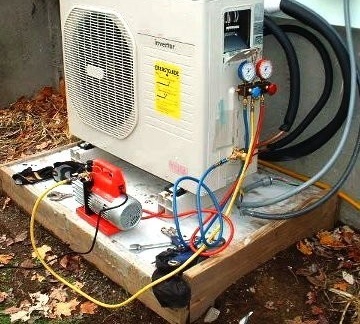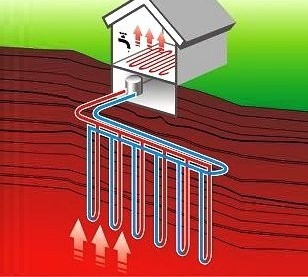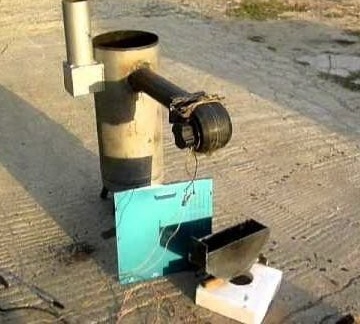Air-to-water heat pump: a review of self-design technology
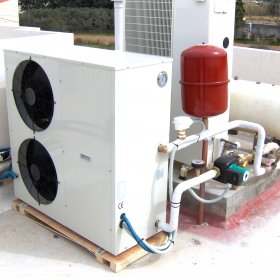
A modern air-to-water heat pump is an extremely useful device. Even if the outdoor temperature approaches zero, it can be used to successfully heat fairly large rooms. If heat pumps of the "ground-water" or "water-water" type are easier to install in a private house with a spacious plot, then the "air-water" model is installed without problems in urban buildings, both residential and office.
Content
How does this system work?
The world around us is full of energy, you only need to collect it and use it correctly. For this, air-water heat pumps are designed. With their help, it is possible to collect low-potential energy from the environment and convert it into high-potential heat, which can heat the home very efficiently. Experts call this process the inverse Carnot principle, on the basis of which refrigeration units work.
With the help of a powerful fan, ordinary air is taken from the outside. It contacts the evaporator, inside of which there is a refrigerant circulating along the coil. When heated, the refrigerant evaporates and enters the compressor. Here it is compressed and heated to a temperature of about 75 degrees and under pressure enters the condenser. There, the refrigerant condenses and becomes liquid, giving off heat to the home heating system. The liquid refrigerant enters the evaporator, where it heats up under the influence of external air, etc. The cycle “heating-evaporation-compression-condensation” is repeated again and again.

The external unit of the air-water heat pump is placed on the site, choosing for this purpose near the house a place with good air circulation
All types of heat pumps are recommended to be used not with traditional radiators, but with those types of heating that do not require heating coolant to high temperatures. They include "warm floor», air heating, large area radiators, etc.
Advantages and disadvantages of such heating
A modern air-to-water heat pump is efficient and can significantly save on heating, because:
- air can be called the most affordable and cheapest renewable resource;
- the cost of installing such a unit will be cheaper than installing other types of heat pump (soil-water, water-water, etc.), and the whole process is simpler and faster;
- heating can be carried out even at a negative outside temperature;
- the device works almost silently;
- efficient indoor air exchange is provided;
- installation control can be carried out automatically.
Indeed, when constructing an air heat pump, one does not need to drill wells or carry out large-scale excavation, there is no need to construct a heat exchanger for the external circuit, etc. Two small channels will be needed through which air will be taken in and then returned to the outside. For this, two small insulated the pipeline. There are models that do not need such pipelines.

For an air-water heat pump, you will need a large fan that will supply air flows to the evaporator. Fan blades must be covered with grill.
There are few drawbacks to this design, but they should be taken into account. Although it is believed that an air heat pump can work efficiently all year round, it is still better to use it in areas with mild and warm winters. It is not recommended to turn on such a heat pump at temperatures below -7 degrees. At the same time, the efficiency of the system in winter will be lower than in spring or autumn. Although manufacturers claim that industrial models of heat pumps of this type can quite successfully work at -25 Celsius. In an area with a harsh climate, the combination of a heat pump and a traditional boiler, which turns on only when severe colds occur, may be the most profitable option.
Of course, for the operation of any heat pump, electricity is needed. For each kilowatt of electricity spent, the device allows you to get 3-4 kW of natural energy. Therefore, ultimately, the use of a heat pump for heating is cost-effective compared to the cost of heating with gas, diesel, solid fuel or heating with an electric boiler. However, you should not forget about the dependence of the system on the availability of electricity.
Algorithm for assembling a homemade unit
Almost all the elements of an air heat pump can be made independently. It is recommended to remove the compressor from a conventional split system. As a rule, such a device has suitable characteristics and works quite quietly. In addition to the compressor, a number of materials will be needed:
- stainless steel metal tank with a volume of 100 l or more;
- plastic barrel with a wide neck;
- copper pipes of various diameters (pipe wall thickness - at least 1 mm);
- set of couplings and adapters;
- electrodes
- drain cock;
- air blower DU-15;
- safety valve;
- manometers;
- devices for automatic control;
- brackets for mounting system elements;
- freon and others
Note! When the compressor is turned on, a sufficiently large current will be required, therefore, the recommended rated load of the electric meter in the house should be at least 40A.
To make an air heat pump, you must:
- Stock up on a suitable compressor and wall mount brackets. To make a 9kW heat pump, you need a 7.2 kW compressor.
- To make a coil from a copper tube by uniformly wrapping the tube around a cylinder of the desired diameter.
- To make a capacitor, cut in half a steel tank into 100 liters, insert a copper coil inside.
- Brew the tank and install the screw connections. To install the finished capacitor, you will also need brackets.
- Cut the plastic barrel to make an evaporator.
- Insert a ¾ inch copper coil from the pipe into the evaporator.
- To mount the evaporator on the wall, you need another set of L-shaped brackets.
- Connect the elements into a common system.
- Invite a refrigeration master who will check build quality and pump refrigerant into the system.
After this, it is necessary to ensure the intake of external air and its discharge for contact with the evaporator, as well as connect the device to the heating system of the house.
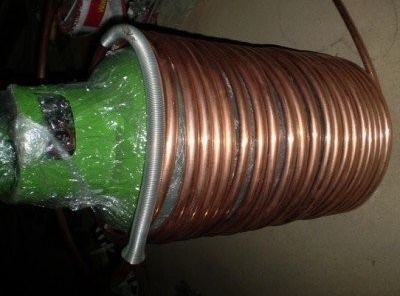
To make a coil from a copper tube for an air-water heat pump, you can take a cylinder of a suitable diameter from under freon or gas and carefully wind the tube over it
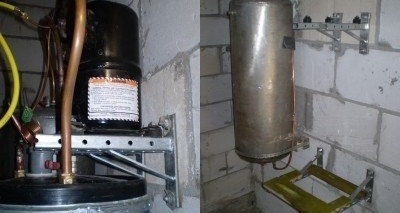
The compressor for the air-water heat pump can be removed from the split system, making sure that it has sufficient power. A metal tank is suitable for the manufacture of a capacitor
The basic principles of operation of an air heat pump are presented in the video material using an industrial model as an example:
Please note that if it is decided to use the heat pump in parallel with the boiler, it is recommended to use bypass.
A few words about power calculations
Before starting work on the creation of the pump, you should determine its power. Do not make the unit “with a margin”, as this will entail completely unnecessary material costs. Lack of power will affect the efficiency of the system, in which case the house will be too cold.
For detailed calculations of the heat pump power, specialists use special programs that allow you to determine other parameters, for example, the area of a copper coil, etc. Folk craftsmen do it easier - they use online calculators that are installed on some specialized sites. In the special fields you should enter data on:
- the region in which the premises are located;
- total area of a private house;
- the height of the ceilings in the rooms;
- degree of insulation of the building.
Based on these data, the program will give the calculated power of the heat pump. Of course, the better the building is insulated, the less heat will be needed to heat it, therefore it is recommended to solve the problem of thermal insulation before installation. For you, we provide indicative data for general reference.
Estimated dependence of the required heating capacity of heat pumps on the area of the house with good thermal insulation properties
| Area, sq. M. | 100 | 150 | 200 | 250 | 300 | 350 |
| Power TH kW. | 5,0 | 8,0 | 12,0 | 16,0 | 21,0 | 28,0 |
Proper Maintenance Technology
The operation of the heat pumps is automatically regulated, therefore, this system does not require any special daily care. Nevertheless, it is recommended to periodically, at least once a year, inspect all elements of the system in order to identify possible problems and prevent them. The owner of the heat pump should:
- Check the condition of all available filters and clean them.
- Monitor the temperature of the oil in the compressor (it should be warm).
- Remove debris trapped in the outdoor heat exchanger.
- Remove dust and dirt from temperature sensors.
- Check wiring status and connection lines.
- Inspect hoses, pipes and their connections, revealing leaks.
- If necessary, lubricate the appropriate points on the motor and fan.
Typically, the compressor is equipped with an oil heating system. Before starting the pump, you should leave it turned on for a few hours so that the oil has time to warm up. Without this precaution, equipment can fail very quickly.
